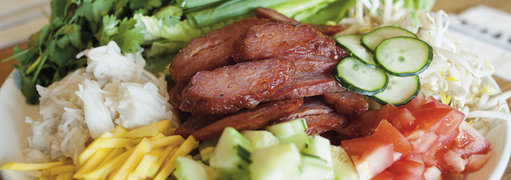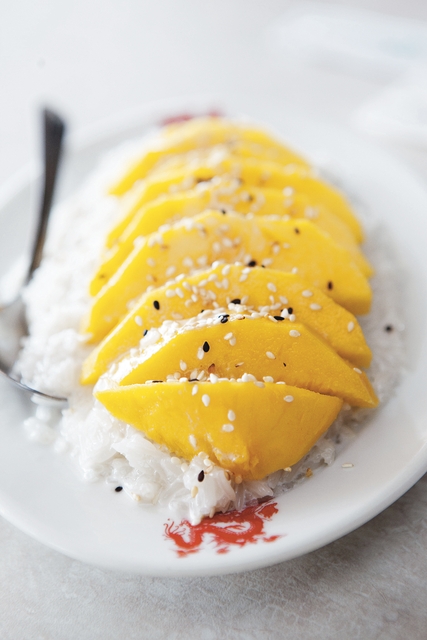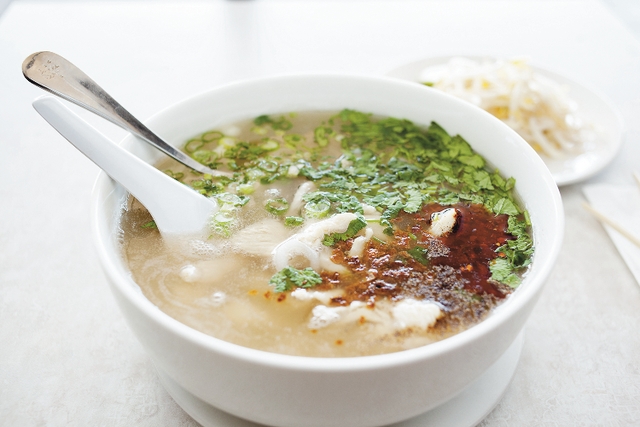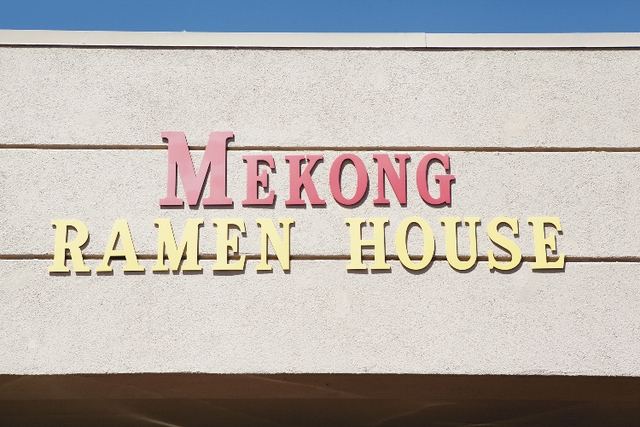If you go to Mekong Ramen House expecting a Japanese-style big city ramen experience, then geography might not be your strong suit.The Mekong River is in Southeast Asia, which is quite a ways from Tokyo. From its Tibetan headwaters, the Mekong flows through China’s Yunnan Province before entering Laos. It traverses the heart of the mainlaind Southeast Asian peninsula, touching Myanmar, Thailand, Cambodia and Vietnam, as well, often serving as a border between these nations. The Mekong is not just the shared lifeblood of the region but the soul of its green, hilly interior. This is especially true in the landlocked country of Laos, which holds the largest section of the river. Laos, like the Mekong, touches every other country in the region, so it isn’t a huge surprise that Mekong Ramen is Laotian-owned, or that its chefs are able to parrot the cuisines of other regions, especially its many neighbors. But Mekong Ramen’s menu pays deep respect to its Lao roots as well, with and without noodles. There is a lot of jungle in the Laotian section of the Mekong, and that biological diversity is reflected in the food’s penetratingly fragrant stems, roots, rhizomes, berries and other plant parts, many of which are too woody or crispy to be chewed. The coconut curries ($8.95-$12.95 depending on the protein) are different from the Thai versions I’ve had around town. The Laotian curries are thinner, rougher and use less sugar or cream to smooth the edges. Large, whole peanuts float in the pale red Masaman curry, which is earthy and subtle. The green curry is thick with slices of bamboo shoot and bell pepper, and the default setting is spicy hot. You’ve been warned. The ramen part of the restaurant’s identity is both gimmicky and legit; gimmicky because it appears to jump aboard the bandwagon of the worldwide Ramen craze, but legit in that all of the noodles served there are house-made, including not just the ramen but the rice and udon noodles, as well.When many people think ramen, they think of Japanese-style ramen soup, and the closest thing on the menu to that would be the Rama Rama ($8.95). Perhaps the name is a nod to the hero Rama from the Indian epic Ramayana, a story that has influenced the spirituality of much of the Mekong. Rama Rama is a Tonkotsu-style ramen, milky from boiled pork parts and graced with fatty slices from a belly-like flesh, plus slices of fish cake and hardboiled egg. The umami-rich broth, in which veggies like bok choy and carrots float, carries a hint of ginger and a nest of fresh noodles that were toothy enough to put up a moment of resistance as we bit down, but quickly surrendered into starchy curds in our mouths.While I have no experience in the ramen houses of New York or Tokyo, and thus no basis on which to rate this rendition’s authenticity or conformity, I enjoyed and respected this bowl of soup. The ramen theme is pushed in other ways, some of which are more successful than others. The cucumber ramen salad ($5.95), in which cucumber slices are tossed with crispy ramen in a sweet chile sauce, is sweet enough for dessert and on the gimmicky end of the spectrum. The pad Thai ramen ($8.95-10.95), in which rice noodles are swapped for ramen, didn’t work. But the rad ramen ($8.95-10.95), in which ramen noodles are fried in a sauce all its own, was a success. The ramen were clothed in sweet, sour, limey wowness, with black pepper—a major export of the region—and the pork version came with juicy slices of pig flesh. Even with the homemade noodles, many of the noodle dishes, while solid, were somewhat ordinary, like the pad thai classic ($8.95—10.95), or the pho Mekong ($8.95). Instead of those, I’d choose the dishes that are more like getting lost in the jungle. Mekong Ramen’s version of yum woon sen ($8.95), the Thai bean thread noodle salad, is particularly spectacular. The thin, rubbery noodles are tossed with whole shrimp and chunks of chicken, and flavored with tomato, lemongrass, onions, black fungus, herbs, lime and fish sauce, and is served in a massive pile that sits atop leaves of cabbage. The spicy Thai noodle soup ($8.95), takes the classic Thai version of tom yum soup to new places. Button mushroom halves and curled, dried lime leaves float in the spicy broth, which is aggressive with bold flavors, only some of which were recognizable, like green onion, lemongrass, tomato, galanga root and its more common cousin ginger. There may also have been tingly Szechuan pepper as well in the tart, raspy broth. This bowl of the best tom yum in town also contains a pile of homemade rice noodles. (At dinner, little bowls of this broth are sometimes delivered between courses).A very popular salad of the region, papaya salad, comes two ways: Thai style—aka what Americans expect from Thai restaurants—and Laos-style, which is closer to what you’d find in Thailand. The Thai-style version ($7.95) has bright white slivers of green papaya and a light, sweet sauce. The shreds of papaya in the Lao papaya salad ($7.95) are darker and much, much fishier. Our young waiter confirmed that there were crushed crabs in the Lao version. I don’t know how literally, or seriously, he was taking my questions, but he smiled a lot (the menu mentions fish sauce, anchovies and shrimp paste but no whole crab). In any event, the Lao papaya salad at Mekong Ramen is the first papaya salad since my time in Bangkok that I couldn’t eat. While the Lao influences are everywhere on the menu, the core Lao dishes are on the Lao Cuisine section of the menu. Our favorite from this list was the nam neung platter ($10.95), in which slices of grilled pork are served with a mountain of raw veggies and noodles. The eater makes DIY lettuce wraps and dips them into a sweet chili peanut sauce. It’s hands-on but clean, and very refreshing.In addition to the orange sections that the friendly waitstaff sometimes brings, there are some winners on the dessert menu ($5.95, all of them). The wonton-wrapped fried bananas are decadent, especially under the sweetened condensed milk-based sauce. The mango and sticky rice does its spectacular job with a hint of salt and dusted with sesame seeds. The chocolate ramen may be gimmicky, but the crispy noodles came flanked with blackberries, strawberries and a chocolate sauce in which to dip them, and there were no complaints at my table.As I waited by the register to pay, I noticed a strange dish on the counter in front of the kitchen, a description of which I had failed to notice on the menu. It consisted of thick sheets of homemade rice flour, in which what looked like flowers or red chile shards were embedded. It’s not on the menu, said one of the women in the kitchen, who told me its name, which I couldn’t even catch, much less remember. In any case it’s not available to customers. It’s for bringing to the temple, she told me. I admit, it’s frustrating that perhaps the most interesting dish on the menu isn’t available—to mortal customers, anyway. But it’s also intriguing. It shows you how loyal the management is to its Mekong roots. They have the skills to take you to some very interesting places, even if a “true” Japanese ramen house isn’t one of them.
Mekong Ramen House3115 San Mateo NE881-2326 Hours: 11am—8:30pm, Monday through Thursday11am—9pm Friday and SaturdayClosed Sundays Vibe : A friendly jungle Booze: BYO Vegetarian and Vegan: accommodated Price Range: $8-10 for entrées The Weekly Alibi recommends:Rama Rama, spicy Thai noodle, yum woon sen, Thai curry, nam neung platter













